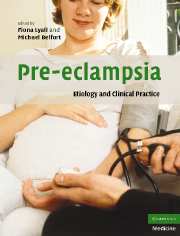Book contents
- Frontmatter
- Contents
- List of contributors
- Preface
- Part I Basic science
- Part II Clinical Practice
- 17 Classification and diagnosis of pre-eclampsia
- 18 Measuring blood pressure in pregnancy and pre-eclampsia
- 19 Immune maladaptation in the etiology of pre-eclampsia; an updated epidemiological perspective
- 20 Genetics of pre-eclampsia and counseling the patient who developed pre-eclampsia
- 21 Thrombophilias and pre-eclampsia
- 22 Medical illness and the risk of pre-eclampsia
- 23 The kidney and pre-eclampsia
- 24 Management of mild pre-eclampsia
- 25 Management of severe pre-eclampsia
- 26 The differential diagnosis of pre-eclampsia and eclampsia
- 27 Complications of pre-eclampsia
- 28 Central nervous system findings in pre-eclampsia and eclampsia
- 29 Pathogenesis and treatment of eclampsia
- 30 Anesthesia for the pre-eclamptic patient
- 31 Critical care management of severe pre-eclampsia
- 32 The role of maternal and fetal Doppler in pre-eclampsia
- 33 Pregnancy-induced hypertension – the effects on the newborn
- 34 Medico-legal implications of the diagnosis of pre-eclampsia
- Subject index
- References
20 - Genetics of pre-eclampsia and counseling the patient who developed pre-eclampsia
from Part II - Clinical Practice
Published online by Cambridge University Press: 03 September 2009
- Frontmatter
- Contents
- List of contributors
- Preface
- Part I Basic science
- Part II Clinical Practice
- 17 Classification and diagnosis of pre-eclampsia
- 18 Measuring blood pressure in pregnancy and pre-eclampsia
- 19 Immune maladaptation in the etiology of pre-eclampsia; an updated epidemiological perspective
- 20 Genetics of pre-eclampsia and counseling the patient who developed pre-eclampsia
- 21 Thrombophilias and pre-eclampsia
- 22 Medical illness and the risk of pre-eclampsia
- 23 The kidney and pre-eclampsia
- 24 Management of mild pre-eclampsia
- 25 Management of severe pre-eclampsia
- 26 The differential diagnosis of pre-eclampsia and eclampsia
- 27 Complications of pre-eclampsia
- 28 Central nervous system findings in pre-eclampsia and eclampsia
- 29 Pathogenesis and treatment of eclampsia
- 30 Anesthesia for the pre-eclamptic patient
- 31 Critical care management of severe pre-eclampsia
- 32 The role of maternal and fetal Doppler in pre-eclampsia
- 33 Pregnancy-induced hypertension – the effects on the newborn
- 34 Medico-legal implications of the diagnosis of pre-eclampsia
- Subject index
- References
Summary
Introduction
Pre-eclampsia runs in families. Analysis of affected families provides compelling evidence that pre-eclampsia is a polygenic, multifactorial disease. It is unlikely that any particular genotype is necessary for the disease to occur; rather, “pre-eclampsia genes” act as susceptibility loci (along with environmental influences) to lower a woman's threshold for developing pre-eclampsia. The available data suggest that some pre-eclampsia-associated mutations are relatively common, and present in a large percentage of women. Other alleles will be “private” mutations, affecting one woman or only a handful of women in an extended family. However, any mutation identified that can dramatically affect even one woman's risk may give us new insights into the pathophysiologic cascade which leads to pre-eclampsia.
Recognizing that a condition is genetic enables the use of gene discovery techniques such as linkage disequilibrium and haplotype mapping to find the genes and the molecular pathways responsible for the illness. Gene mapping techniques have been applied in every field of medicine to uncover the molecular underpinnings of complex human diseases. Undoubtedly, discoveries of pre-eclampsia-related genes will lead to improved means of classification and diagnosis. A major lesson of modern genetics is that syndromes defined on the basis of clustering of clinical symptoms often reveal marked heterogeneity once they are understood at a molecular level. In this respect, the boundaries around pre-eclampsia, gestational hypertension, and HELLP syndrome are likely to be redrawn when genetic determinants can be examined directly.
- Type
- Chapter
- Information
- Pre-eclampsiaEtiology and Clinical Practice, pp. 295 - 304Publisher: Cambridge University PressPrint publication year: 2007



